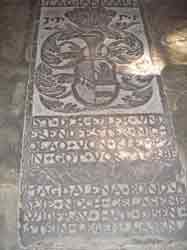Mural paintings under the plasterwork
Still the frescoes, that artists of the past painted on a thick layer of lime plaster, keep most of their secrets.
Anläßlich einer restauratorischen Voruntersuchung konnten 1993 bisher neun (9) Fassungen der Innenraum-Auskleidung festgestellt werden. Am meisten ausgemalt erscheint hier die Ostwand (Altarraum).
On the occasion of an examination in 1993 there could be stated 9 versions of interior coatings. Most of the ornaments seem to be hidden under the plaster of the eastern wall (altar-room) Fortunately the 1st version – painted tendrils from medieval times and painted square stones similar to those at Groß Bisdorf or Reinsberg - could be detected in many places of the interior. The remnants of the 2nd period might originate from the renaissance (time of the altartable 1602 ? ) and cannot be described more detailed without further examinations. Finally remnants of an baroque curtain-painting represent the 3rd period.
To the oldest inventory of our church belongs the double-tombstone of the von-Stedingk-Family ( Vicko and Margaretha von Stedingk 1368). Descendants of this family went to Sweden and since there were in official charge at the royal court of Sweden.

|

|
| Commemorative Stone for Niklas von Klempzen († 1552), 1555 given by Magdalena von Bonow, his widow | Double-Tombstone of the von-Stedingk-Family 1368 |
A very important testimony to the importance of Pinnow and our church in the past is a commemorative stone put into the churchfloor: In 1555 Magdalena von Bonow, the widow of Niklas von Klempzen, gave it in memory of her husband. Nik(o)la(u)s von Klempzen (about 1504 – † 1552 in Stolp/Eastern Pomerania) owned among other things the manors of Pinnow, Bömitz and Klitschendorf. He was „Landrentmeister" – treasurer - of Duke George I° of Pomerania and a chronist of pomeranian history. He decisively influenced the first historiographic collection of pomeranian history (High German edition as „Fragmenta der pomerischen Geschichte" about 1538) by Thomas Kantzow
